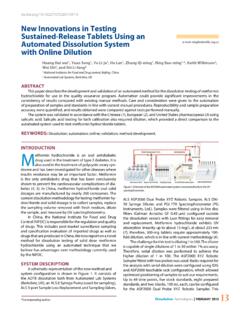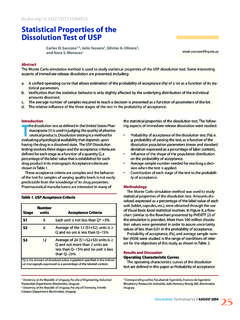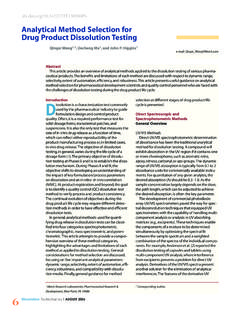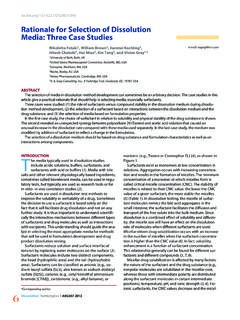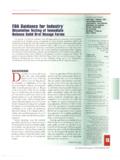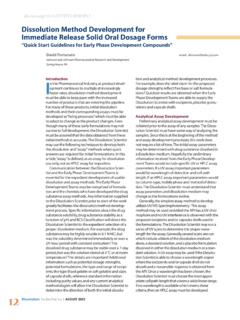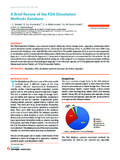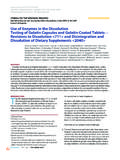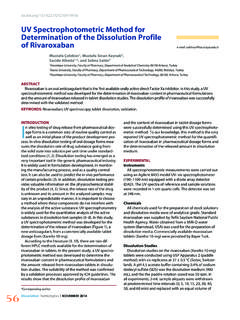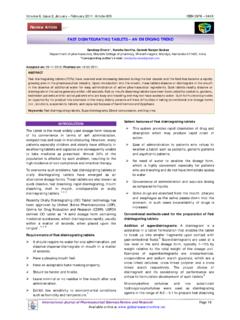Transcription of Physicochemical Characterization and Dissolution …
1 Physicochemical Characterization and Dissolution study of Ibuprofen compression - coated tablets Using e-mail: Locust Bean Gum Negar Bashardoust1,2, J. Josephine Leno Jenita1, and Parvin Zakeri Milani3,*. 1 Department of Pharmaceutics, Dayananda Sagar College of Pharmacy, Kumaraswamy, Layout, Bangalore 560078, Karnataka, India 2 Student Research Committee, Tabriz University of Medical Sciences, Tabriz, Iran 3 Drug Applied Research Center and Faculty of Pharmacy, Tabriz University of Medical Sciences, Tabriz, Iran ABSTRACT. The aim of the present study was to minimize drug release in the upper gastro intestinal tract and target the colon using the principles of compression coating. compression - coated tablets of ibuprofen were prepared by a direct compression method using locust bean gum (LBG) at 300, 250, 200, and 175 mg. tablets were evaluated for their Physicochemical proper- ties and in vitro drug release.
2 In vitro drug release studies were performed with and without rat caecal contents. In rat caecal contents, tablets showed enhanced drug release due to degradation of the LBG coating by colonic enzymes. The in vitro re- lease studies in pH phosphate buffer containing 2% w/v rat caecal contents showed the cumulative percentage release of ibuprofen after 26 h as , , , and % Coating thickness and the amount of chitosan control the release rate. Formulations were best fitted with Korsmeyer Peppas kinetics, and the mechanism of drug release was non-Fickian super case II transport. FTIR studies reveal there is no drug polysaccharide interaction. The F1. formulation is a promising system for drug targeting to the colon. INTRODUCTION to the family Fabaceae (4). It consists chiefly of high mo- C. olonic delivery refers to targeting drugs to the lecular weight hydrocolloidal polysaccharides composed colon for treatment of its local diseases.
3 It is also of galactose and mannose units (1:4) combined through considered as an oral delivery method for drugs glycosidic linkages. This natural, non-starch polysac- that are unstable, unabsorbed in the upper GI tract, or charide forms water-insoluble films that degrade in both. Additionally, the other category of drugs targeted to colonic microflora, making it useful in a colon-targeting this site includes drugs that need delayed absorption from strategy (5). On the other hand, LBG has various proper- a therapeutic point of view. This site of the GI tract pres- ties that make it a good choice in drug delivery: (1) it is ents a nearly neutral pH, longer residence time, and less biocompatible, biosorbable, biodegradable, cheap, and enzymatic activity, which makes it less hostile compared abundant; (2) it is nonteratogenic and nonmutagenic with the proximal part of the GIT (1).
4 According to Joint FAO/WHO Expert Committee on Food There are several pharmaceutical approaches to Additives held in Geneva, April 1975; (3) it has acceptable prepare colon-targeted drug delivery systems. These shelf-life; and (4) its degradation products are excreted approaches could be categorized in two main classes (2). readily (4). The first is covalent linkage of the drug with a carrier to The aim of the present study was to develop a new make conjugates, and the second approach is deliver- colon-specific, compression - coated formulation for ing intact molecules to the colon. The second approach ibuprofen using LBG as coating material. Ibuprofen, a itself is subdivided into seven subclasses. These include non-steroidal anti-inflammatory agent, was selected systems developed using polymer coatings (pH-sensitive, for formulation because of its most common adverse biodegradable polymers), systems embedded in matrices effect, gastrointestinal discomfort.
5 Moreover, it is well (biodegradable matrices, hydrogels, pH-sensitive matri- absorbed throughout the colon and also reported to ces), time-released systems, systems with redox-sensitive decrease both tumor growth and metastatic potential polymers, bioadhesive systems, microparticle- coated in mice (6, 7). systems, and osmotic controlled-delivery systems (2, 3). Locust bean gum (LBG), also known as carob gum, is a MATERIALS AND METHODS. galactomannan vegetable gum derived from the seeds Ibuprofen was obtained from Strides Acro Labs, of the leguminous plant Ceratonia siliqua Linn belonging Bangalore, India. Locust bean gum was purchased from Alembic Pharma, Baroda, India. Sodium hydroxide pellets *Corresponding author. were received from SD Fine-Chem. Ltd., Mumbai, India. 38 Dissolution Technologies | FEBRUARY 2013. Talc was obtained from Leo Chem.
6 , Bangalore, India. was carefully placed in the center of the die cavity Potassium chloride and potassium bromide (IR grade) (Table1). The compression pressure was 5000 kg, and were from Thomas Baker, Mumbai, India and Merck spe- the strength of the compression - coated tablets was 5. cialities Pvt. Ltd., Germany, respectively. Microcrystalline kg/cm2. The resulting coating had adequate hardness cellulose, sodium starch glycolate, potassium dihydro- due to the use of microcrystalline cellulose in the coat- gen phosphate, and magnesium stearate were obtained ing formulation. from Spectrochem Pvt. Ltd., Mumbai. Hydrochloric acid (HCl) was provided by Swastik Pharmaceuticals, Mumbai, Characterization of compression - coated tablets India. The instruments used were as follows: FTIR spec- Prepared tablets were subjected to quality control tests trometer (FTIR-8400S, Shimadzu, Japan), UV-vis spec- including hardness, friability, weight variation, and unifor- trophotometer (UV-1800, Shimadzu, Japan), Disso DS mity of drug content tests.
7 These studies were carried out 14000 Dissolution test apparatus (LabIndia, India), C-DS according to USP methods (8). 3 disintegration test apparatus (Serwell Instruments Inc., Bangalore, India), 12-station tablet compression machine Drug Release Studies in the Presence and Absence of (IP/BP/USP standard, Karnavati Engineering, Ahmedabad, Rat Caecal Contents India), hot-air oven (Serwell Instruments Inc., Banga- In the first step, drug release from tablets was char- lore, India), ATL-224-I digital balance (Acculab Sartorius acterized using the USP basket Dissolution apparatus Group, Bangalore, India), Shore Hardness Tester model and 900 mL of acidic buffer ( N HCl, pH ) and HT-6510A (Scientific Engineering Corp., Delhi, India), pH phosphate buffer as test media for 2 h and 3. hydraulic pellet press model KP-974 (S. V. Scientific ), pH h, respectively.
8 A stirring speed of 100 rpm was used. meter (Serwell Instrument Inc., Bangalore, India), FT-20 Two samples of 1 mL were withdrawn and immediately friability tester (Dutta Scientific Works., Madras, India), filtered. Drug concentration was measured spectropho- and CHM-6 Plus humidity cabinet (Remi Laboratories tometrically. Ltd., India). In the next step, release profiles were examined using the rat caecal contents as Dissolution medium (9) to Preparation of Optimized Core tablets of Ibuprofen check whether tablet cores might be affected as the Each core tablet for in vitro studies consisted of dosage form passes through the GI tract. Drug release ibuprofen (100 mg), dried starch (4 mg), and micro- studies in the presence of caecal contents were carried crystalline cellulose (MCC, 46 mg). Starch was added to out using USP Apparatus 1 with a slight modification in obtain quickly disintegrating tablets .
9 All materials were procedure. The experiments were carried out in 200-mL. weighed, mixed, and passed through a 250- m mesh beakers immersed in water contained in the 1000-mL. to ensure complete mixing. The tablets were prepared vessel that was maintained in the water bath of the by compressing the thoroughly mixed materials us- Dissolution test apparatus. Initial studies were carried ing 7-mm round, flat, plain punches on a single-station out in 200 mL of N HCl (pH ) for 2 h. After this, the tablet machine (Cadmach, India). The thickness of the Dissolution medium was replaced with 200 mL of pH. core tablets was mm, and their crushing strength was phosphate buffered saline (PBS), and the Dissolution about 3 kg/cm2. continued for another 3 h. Then a drug release study was carried out in pH buffer medium containing compression Coating of Ibuprofen Core tablets 2% w/v rat caecal contents for 21 h (100 rpm, 37 C).
10 As The coating material, consisting of different amounts the caecum is naturally anaerobic, all experiments in of LBG (270, 220, 170, 145, and 120 mg), was com- caecal content media were conducted under a con- pressed on the previously prepared core tablet, which tinuous supply of nitrogen. At different time intervals, 1-mL samples were withdrawn from the Dissolution medium and replenished with 1 mL of 2% w/v caecal contents maintained under anaerobic conditions to Table 1. Composition of Locust Bean Gum Coats Used to maintain a constant volume. The samples were diluted Cover Ibuprofen Core tablets and analyzed spectrophotometrically. The Institutional Composition (mg) Animal Ethics Committee approved the experimental Batch Coat Weight protocol for preparation of rat caecal contents. Briefly, code (mg) LBG MCC Mg Stearate Talc five Wister rats weighing between 200 and 300 g were F1 300 270 25 2 3 kept on a normal diet and administered 1 mL of 2% w/v F2 250 220 25 2 3 solution of LBG in water through Teflon tubing placed F3 200 170 25 2 3 directly into stomach region via the oral cavity.
